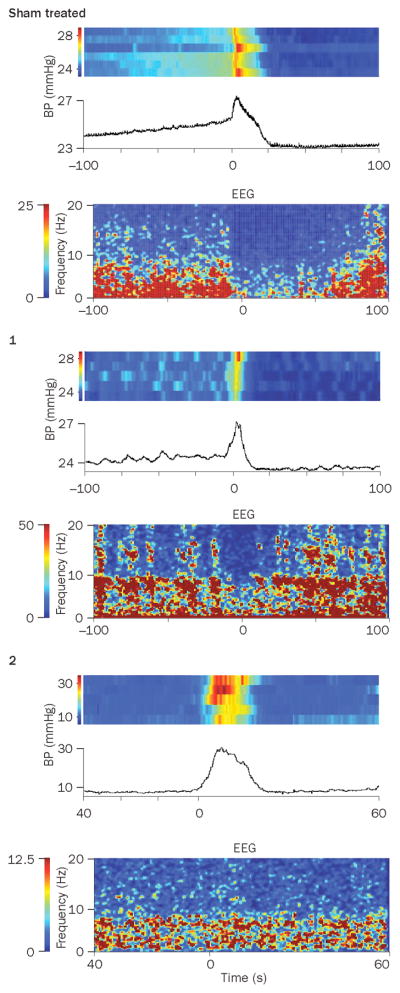Figure 4.


Effect of partial bladder obstruction on the relationship between bladder pressure and cortical EEG. A. Simultaneous EEG and cystometry recordings from sham and obstructed rats. From top to bottom, the traces show raw EEG, bladder pressure (BP, mm Hg), bladder capacity (BC, ml), micturition volume (MV, ml), and EEG power spectrum (PSD). An obstructed rat (1) has a similar urodynamic pattern as the sham rat with the exception of spontaneous non-voiding contractions but has a distinct EEG pattern characterized by a peak at 7.5 Hz (theta oscillation). Obstructed rat 2 does not exhibit non-voiding contractions, but shows increased micturition frequency. In this case the EEG is characterized by lower amplitude and a shift towards higher frequencies. B1 and B2 show peri-event spectrograms generated from the same subjects as in A, indicating how power in different EEG frequency bands co-varies with bladder pressure during individual micturition cycles. In B1, the traces represent mean bladder pressure over 4–5 micturition cycles and centered at the micturition threshold (time=0). The heat map above each trace represents bladder pressure for each micturition cycle. For the sham rat, a uniform increase in bladder pressure up to micturition threshold can be seen. In contrast, for Obstructed (1) non-voiding contractions are indicated in the heat map as sporadic episodes (lighter blue blocks interspersed within darker blue) that occur up to the point at which micturition threshold is reached. Obstructed (2) does not exhibit non-voiding contractions. B2 shows heat maps that indicate the mean relative power in different EEG frequency bands (0–20 Hz, ordinate) and these are time-locked with B1, such that time=0 indicates the point of the micturition threshold. Note how the different patterns of bladder activity produced by obstruction impact on the relationship between bladder pressure and cortical EEG activity. In sham rats a decrease in power in all frequencies (i.e., desynchronization) precedes the micturition threshold and is maintained. Obstructed 1 with non-voiding contractions has greater power in higher frequencies (7–10 Hz and 14–15 Hz) that fluctuate like the contractions. In Obstructed 2 that has frequent micturition cycles and no non-voiding contractions, cortical EEG is desynchronized throughout the session and increases in bladder pressure up to the micturition threshold are without effect. Reproduced with permission from reference 63.
